
Mobile Suit Gundam, also known as First Gundam, Gundam 0079 or simply Gundam '79, is an anime television series, produced and animated by Nippon Sunrise. Created and directed by Yoshiyuki Tomino, it premiered in Japan on Nagoya Broadcasting Network and its affiliated ANN stations on April 7, 1979, and lasted until January 26, 1980, spanning 43 episodes. It was the first Gundam series, which has subsequently been adapted into numerous sequels and spin-offs. Set in the futuristic calendar year "Universal Century" 0079, the plot focuses on the war between the Principality of Zeon and the Earth Federation, with the latter unveiling a new giant robot known as the RX-78-2 Gundam piloted by the teenage civilian mechanic Amuro Ray.
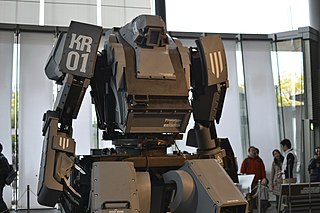
In science fiction, mecha or mechs are giant robots or machines typically depicted as piloted and as humanoid walking vehicles. The term was first used in Japanese after shortening the English loanword 'mechanism' or 'mechanical', but the meaning in Japanese is more inclusive, and 'robot' or 'giant robot' is the narrower term.
Gundam is a Japanese military science fiction media franchise. Created by Yoshiyuki Tomino and Sunrise, the franchise features giant robots, or mecha, with the name "Gundam". The franchise began on April 7, 1979, with Mobile Suit Gundam, a TV series that defined the "real robot" mecha anime genre by featuring giant robots called mobile suits in a militaristic setting. The popularity of the series and its merchandise spawned a franchise that includes 50 TV series, films and OVAs as well as manga, novels and video games, along with a whole industry of plastic model kits known as Gunpla which makes up 90 percent of the Japanese character plastic-model market.
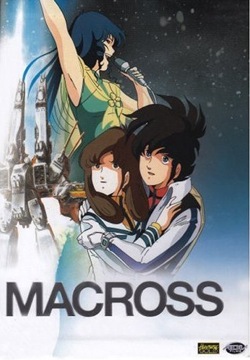
Super Dimension Fortress Macross is an anime television series from 1982. According to story creator Shoji Kawamori, it depicts "a love triangle against the backdrop of great battles" during the first Human-alien war. It is the first part of: The Super Dimension trilogy and the Macross franchise.

Yoshiyuki Tomino is a Japanese anime director, screenwriter, songwriter and novelist best known for creating the Gundam anime franchise.

Macross is a Japanese science fiction mecha anime media franchise/media mix, created by Studio Nue and Artland in 1982. The franchise features a fictional history of Earth and the human race after the year 1999, as well as the history of humanoid civilization in the Milky Way. It consists of four TV series, four movies, six OVAs, one light novel, and five manga series, all sponsored by Big West, in addition to 40 video games set in the Macross universe, two crossover games, and a wide variety of physical merchandise.
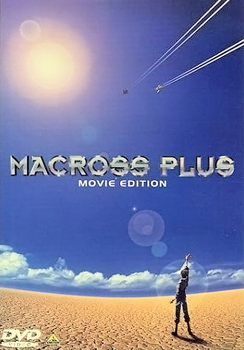
Macross Plus is a four-episode anime OVA and theatrical movie in the Macross series. It was the first sequel to the original Macross television series that took place in the official timeline. Plus was a groundbreaking combination of traditional cel and computer-generated animation at the time of its release, paving the way for the incorporation of more computer-generated imagery in Japanese animation.

In the Macross Japanese anime series and its English adaptation Robotech, the first mass-produced transforming aerospace fighter mecha is called the VF-1 Valkyrie. The VF-1 Valkyrie is referred to as a "variable fighter" in Macross.
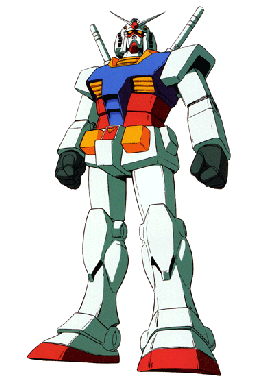
The RX-78-2 Gundam is a fictional manned robot (mecha), introduced in 1979 in Yoshiyuki Tomino's and Sunrise's anime series Mobile Suit Gundam. In the series, it is a prototype weapon for the Earth Federation when it falls into the hands of Amuro Ray, the son of its designer in story, who goes on to pilot it in the Earth Federation's war against the Principality of Zeon.
Diaclone is a toyline by Takara Toys launched in 1980. It consisted of transforming vehicles and robots piloted by miniature, magnet-shoed figures spun off from the prior Microman toy line.
Super Robot Wars, known in Japan as Super Robot Taisen, is a series of Japanese tactical role-playing video games produced by Bandai Namco Entertainment, formerly Banpresto. Starting out as a spinoff of the Compati Hero series, the main feature of the franchise is having a story that crosses over several popular mecha anime, manga and video games, allowing characters and mecha from different titles to team up or battle one another. The first game in the franchise was released for the Game Boy on April 20, 1991. Later spawning numerous games that were released on various consoles and handhelds. Due to the nature of crossover games and licensing involved, only a few games have been released outside Japan, and in English. The franchise celebrated its 25th anniversary in 2016, and its 30th anniversary in 2021.

Shōji Kawamori is a Japanese anime creator and producer, screenwriter, visual artist, and mecha designer. He is best known for creating the Macross mecha anime franchise and the Diaclone toyline, which were in turn the basis for the Robotech and Transformers franchises, respectively. He is also known for creating The Vision of Escaflowne anime series. He pioneered several innovative concepts in his works, such as transforming mecha and virtual idols. His work has had a significant impact on popular culture, both in Japan and internationally.

Mobile Suit Gundam: Hathaway's Flash also known as Mobile Suit Gundam Hathaway, is a novel series created and written by Yoshiyuki Tomino. Officially part of the Gundam metaseries, it was first published by Kadokawa Shoten under the Kadokawa Sneaker Bunko label from February 1, 1989 to April 1, 1990 with a total of three volumes. The story revolves around Hathaway Noa, who now goes by the name Mafty Navue Erin, as he starts a terrorist group to stop the abuses of the Earth Federation. The novel was notable for being the only semi-canonical Gundam work by Tomino. A three-part theatrical film adaptation was formally announced by Bandai Namco Filmworks as part of the "UC NexT 0100" project. The first film was released on June 11, 2021.

Kunio Okawara is a mecha designer in the Japanese anime industry. He was born and currently lives in Inagi, Tokyo, where he works out of a studio in his home.
The Brave series is a Japanese toy and anime franchise originally produced by Sunrise, Nagoya TV, Victor Entertainment and Tokyu Agency, originally created by Takara. The franchise ran from 1990s to 2000s, producing eight official series and several side media including Original Video Animations (OVAs), toys, and several memorabilia in Japan. It was one of Sunrise's notable productions in the 90s, and its run play a key role in the reintroduction of the Super Robot genre to the Japanese mainstream.

Science fiction is an important genre of modern Japanese literature that has strongly influenced aspects of contemporary Japanese pop culture, including anime, manga, video games, tokusatsu, and cinema.
Kazutaka Watanabe, better known as Kazutaka Miyatake, is a Japanese visual artist and anime designer known for the mechanical design of the Macross TV series and a number of its continuations from Studio Nue, of which he is a founding member. He has also contributed to the mecha design of other series such as Mobile Suit Gundam SEED Destiny.
Studio Nue, Inc. is a Japanese design studio formed in 1972 by Naoyuki Kato, Kenichi Matsuzaki, Kazutaka Miyatake, and Haruka Takachiho. Crystal Art Studio would change their name to Studio Nue in 1974.

Space Gundam V is a South Korean animated film directed by Kim Cheong-gi, released on July 21, 1983. Despite its title, the series is not related to Mobile Suit Gundam. It is known for incorporating an unlicensed version of the VF-1J Valkyrie of Macross fame and the heroic elements of Brave Raideen.
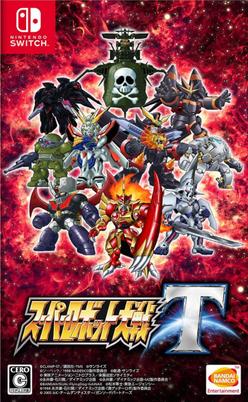
Super Robot Wars T is a tactical role-playing game developed by B.B. Studio and published by Bandai Namco Entertainment. It is the eleventh standalone entry to the Super Robot Wars series and the third installment of the "International Era" series, with the game's continued focus on the massive crossover between different mecha anime series released in Japan. Released for the PlayStation 4 and Nintendo Switch, it was also released in Asia on March 20, 2019.














